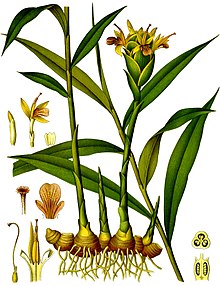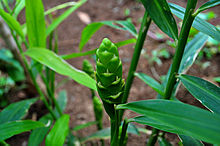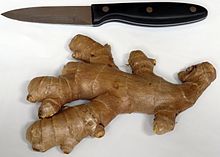Ginger
| Ginger | |
|---|---|
 | |
| 1896 color plate from Köhler's Medicinal Plants | |
 | |
| Inflorescence | |
Scientific classification | |
| Kingdom: | Plantae |
Clade: | Angiosperms |
Clade: | Monocots |
Clade: | Commelinids |
| Order: | Zingiberales |
| Family: | Zingiberaceae |
| Genus: | Zingiber |
| Species: | Z. officinale |
Binomial name | |
Zingiber officinale Roscoe[1] | |
Ginger (Zingiber officinale) is a flowering plant whose rhizome, ginger root or ginger, is widely used as a spice and a folk medicine.[2]
It is a herbaceous perennial which grows annual pseudostems (false stems made of the rolled bases of leaves) about a meter tall bearing narrow leaf blades. The inflorescences bear pale yellow with purple flowers and arise directly from the rhizome on separate shoots.[3] Ginger is in the family Zingiberaceae, to which also belong turmeric (Curcuma longa), cardamom (Elettaria cardamomum), and galangal. Ginger originated in the tropical rainforests from the Indian subcontinent to Southern Asia where ginger plants show considerable genetic variation.[4] As one of the first spices exported from the Orient, ginger arrived in Europe during the spice trade, and was used by ancient Greeks and Romans.[5] The distantly related dicots in the genus Asarum are commonly called wild ginger because of their similar taste.
Contents
1 Etymology
2 Origin and distribution
3 Horticulture
4 Production
5 Uses
5.1 Regional uses
5.2 Similar ingredients
6 Nutritional information
7 Composition and safety
7.1 Chemistry
8 Medicinal use and research
9 Gallery
10 References
11 External links
Etymology
The English origin of the word, "ginger", is from the mid-14th century, from Old English gingifer, from Medieval Latin gingiber, from Greek zingiberis, from Prakrit (Middle Indic) singabera, from Sanskrit srngaveram, from srngam "horn" and vera- "body", from the shape of its root.[6] The word probably was readopted in Middle English from Old French gingibre (modern French gingembre).[7]
Origin and distribution

Ginger plant with flower
Ginger likely originated as ground flora of tropical lowland forests in regions from the Indian subcontinent to southern Asia,[5] where its cultivation remains among the world's largest producers, including India, China, and other countries of southern Asia (see Production). Numerous wild relatives are still found in these regions,[5] and in tropical or subtropical world regions, such as Hawaii, Japan, Australia, and Malaysia.[4]
Horticulture
Ginger produces clusters of white and pink flower buds that bloom into yellow flowers. Because of its aesthetic appeal and the adaptation of the plant to warm climates, it is often used as landscaping around subtropical homes. It is a perennial reed-like plant with annual leafy stems, about a meter (3 to 4 feet) tall.
Traditionally, the rhizome is gathered when the stalk withers; it is immediately scalded, or washed and scraped, to kill it and prevent sprouting. The fragrant perisperm of the Zingiberaceae is used as sweetmeats by Bantu, and also as a condiment and sialagogue.[8]
| Ginger production, 2016 | ||||
|---|---|---|---|---|
| Country | Production (tonnes) | |||
1,109,000 | ||||
522,964 | ||||
463,707 | ||||
340,341 | ||||
271,863 | ||||
164,266 | ||||
World | 3,270,762 | |||
Source: Food and Agricultural Organization of the United Nations, Statistics Division (FAOSTAT)[9] | ||||
Production
In 2016, global production of ginger was 3.3 million tonnes, led by India with 34% of the world total. Nigeria, China, and Indonesia also had substantial production.[9]
Uses

Fresh ginger rhizome

Freshly washed ginger
Ginger produces a hot, fragrant kitchen spice.[5] Young ginger rhizomes are juicy and fleshy with a mild taste. They are often pickled in vinegar or sherry as a snack or cooked as an ingredient in many dishes. They can be steeped in boiling water to make ginger herb tea, to which honey may be added. Ginger can be made into candy or ginger wine.
Mature ginger rhizomes are fibrous and nearly dry. The juice from ginger roots is often used as a seasoning in Indian recipes and is a common ingredient of Chinese, Korean, Japanese, Vietnamese, and many South Asian cuisines for flavoring dishes such as seafood, meat, and vegetarian dishes.
Fresh ginger can be substituted for ground ginger at a ratio of six to one, although the flavors of fresh and dried ginger are somewhat different. Powdered dry ginger root is typically used as a flavoring for recipes such as gingerbread, cookies, crackers and cakes, ginger ale, and ginger beer. Candied ginger, or crystallized ginger, is the root cooked in sugar until soft, and is a type of confectionery. Fresh ginger may be peeled before eating. For longer-term storage, the ginger can be placed in a plastic bag and refrigerated or frozen.
Regional uses
In Indian cuisine, ginger is a key ingredient, especially in thicker gravies, as well as in many other dishes, both vegetarian and meat-based. Ginger also has a role in traditional Ayurvedic medicine. It is an ingredient in traditional Indian drinks, both cold and hot, including spiced masala chai. Fresh ginger is one of the main spices used for making pulse and lentil curries and other vegetable preparations. Fresh ginger together with peeled garlic cloves is crushed or ground to form ginger garlic masala. Fresh, as well as dried, ginger is used to spice tea and coffee, especially in winter. In south India, "sambharam" is a summer yogurt drink made with ginger as a key ingredient, along with green chillies, salt and curry leaves. Ginger powder is used in food preparations intended primarily for pregnant or nursing women, the most popular one being katlu, which is a mixture of gum resin, ghee, nuts, and sugar. Ginger is also consumed in candied and pickled form. In Japan, ginger is pickled to make beni shōga and gari or grated and used raw on tofu or noodles. It is made into a candy called shoga no sato zuke. In the traditional Korean kimchi, ginger is either finely minced or just juiced to avoid the fibrous texture and added to the ingredients of the spicy paste just before the fermenting process.
In Burma, ginger is called gyin. It is widely used in cooking and as a main ingredient in traditional medicines. It is consumed as a salad dish called gyin-thot, which consists of shredded ginger preserved in oil, with a variety of nuts and seeds. In Thailand' where it is called ขิง khing, it is used to make a ginger garlic paste in cooking. In Indonesia, a beverage called wedang jahe is made from ginger and palm sugar. Indonesians also use ground ginger root, called jahe, as a common ingredient in local recipes. In Malaysia, ginger is called halia and used in many kinds of dishes, especially soups. Called luya in the Philippines, ginger is a common ingredient in local dishes and is brewed as a tea called salabat.[10][11] In Vietnam, the fresh leaves, finely chopped, can be added to shrimp-and-yam soup (canh khoai mỡ) as a top garnish and spice to add a much subtler flavor of ginger than the chopped root. In China, sliced or whole ginger root is often paired with savory dishes such as fish, and chopped ginger root is commonly paired with meat, when it is cooked. Candied ginger is sometimes a component of Chinese candy boxes, and a herbal tea can be prepared from ginger.
In the Caribbean, ginger is a popular spice for cooking and for making drinks such as sorrel, a drink made during the Christmas season. Jamaicans make ginger beer both as a carbonated beverage and also fresh in their homes. Ginger tea is often made from fresh ginger, as well as the famous regional specialty Jamaican ginger cake. On the island of Corfu, Greece, a traditional drink called τσιτσιμπύρα (tsitsibira), a type of ginger beer, is made. The people of Corfu and the rest of the Ionian islands adopted the drink from the British, during the period of the United States of the Ionian Islands.
In Western cuisine, ginger is traditionally used mainly in sweet foods such as ginger ale, gingerbread, ginger snaps, parkin, and speculaas. A ginger-flavored liqueur called Canton is produced in Jarnac, France. Ginger wine is a ginger-flavored wine produced in the United Kingdom, traditionally sold in a green glass bottle. Ginger is also used as a spice added to hot coffee and tea.
 Ginger section | |
| Nutritional value per 100 g (3.5 oz) | |
|---|---|
| Energy | 333 kJ (80 kcal) |
Carbohydrates | 17.77 g |
| Sugars | 1.7 g |
| Dietary fiber | 2 g |
Fat | 0.75 g |
Protein | 1.82 g |
| Vitamins | Quantity %DV† |
| Thiamine (B1) | 2% 0.025 mg |
| Riboflavin (B2) | 3% 0.034 mg |
| Niacin (B3) | 5% 0.75 mg |
| Pantothenic acid (B5) | 4% 0.203 mg |
| Vitamin B6 | 12% 0.16 mg |
| Folate (B9) | 3% 11 μg |
| Vitamin C | 6% 5 mg |
| Vitamin E | 2% 0.26 mg |
| Minerals | Quantity %DV† |
| Calcium | 2% 16 mg |
| Iron | 5% 0.6 mg |
| Magnesium | 12% 43 mg |
| Manganese | 11% 0.229 mg |
| Phosphorus | 5% 34 mg |
| Potassium | 9% 415 mg |
| Sodium | 1% 13 mg |
| Zinc | 4% 0.34 mg |
| Other constituents | Quantity |
| Water | 79 g |
Full link to USDA Database entry | |
| |
†Percentages are roughly approximated using US recommendations for adults. Source: USDA Nutrient Database | |
Similar ingredients
Myoga (Zingiber mioga 'Roscoe') appears in Japanese cuisine; the flower buds are the part eaten.
Another plant in the Zingiberaceae family, galangal, is used for similar purposes as ginger in Thai cuisine. Galangal is also called Thai ginger, fingerroot (Boesenbergia rotunda), Chinese ginger, or the Thai krachai.
A dicotyledonous native species of eastern North America, Asarum canadense, is also known as "wild ginger", and its root has similar aromatic properties, but it is not related to true ginger. The plant contains aristolochic acid, a carcinogenic compound.[12] The United States Food and Drug Administration warns that consumption of aristolochic acid-containing products is associated with "permanent kidney damage, sometimes resulting in kidney failure that has required kidney dialysis or kidney transplantation. In addition, some patients have developed certain types of cancers, most often occurring in the urinary tract."[12]
Nutritional information
Raw ginger is composed of 79% water, 18% carbohydrates, 2% protein, and 1% fat (table). In 100 grams (a standard amount used to compare with other foods), raw ginger supplies 80 Calories and contains moderate amounts of vitamin B6 (12% of the Daily Value, DV) and the dietary minerals, magnesium (12% DV) and manganese (11% DV), but otherwise is low in nutrient content (table).
When used as a spice powder in a common serving amount of one US tablespoon (5 grams), ground dried ginger (9% water) provides negligible content of essential nutrients, with the exception of manganese (70% DV).[13]
Composition and safety
If consumed in reasonable quantities, ginger has few negative side effects.[14] It is on the FDA's "generally recognized as safe" list,[15] though it does interact with some medications, including the anticoagulant drug warfarin[16] and the cardiovascular drug nifedipine.[17]
Chemistry
The characteristic fragrance and flavor of ginger result from volatile oils that compose 1-3% of the weight of fresh ginger, primarily consisting of zingerone, shogaols and gingerols with [6]-gingerol (1-[4'-hydroxy-3'-methoxyphenyl]-5-hydroxy-3-decanone) as the major pungent compound.[2][18] Zingerone is produced from gingerols during drying, having lower pungency and a spicy-sweet aroma.[18]
Medicinal use and research
Evidence that ginger helps alleviate nausea and vomiting resulting from chemotherapy or pregnancy is inconsistent.[17][19] It is not recommended for any clinical uses or for nausea.[20][21] There is no clear evidence of harm from taking ginger during pregnancy, although its safety has not been established.[21] Ginger is not effective for treating dysmenorrhea,[22] and there is no evidence for it having analgesic properties.[23]
Allergic reactions to ginger generally result in a rash.[17] Although generally recognized as safe, ginger can cause heartburn and other side effects, particularly if taken in powdered form.[17] It may adversely affect individuals with gallstones and may interfere with the effects of anticoagulants, such as warfarin or aspirin.[17][2]
Gallery

ginger flower about to bloom

Ginger Flower overview

Ginger flower stamen

Ginger field

Ginger crop, Myanmar

Two varieties of ginger

Chopped ginger

Gari, a type of pickled ginger

German ginger flavored wine (grape based) with stem ginger decoration
References
^ "Zingiber officinale". Germplasm Resources Information Network (GRIN). Agricultural Research Service (ARS), United States Department of Agriculture (USDA). Retrieved 10 December 2017..mw-parser-output cite.citation{font-style:inherit}.mw-parser-output q{quotes:"""""""'""'"}.mw-parser-output code.cs1-code{color:inherit;background:inherit;border:inherit;padding:inherit}.mw-parser-output .cs1-lock-free a{background:url("//upload.wikimedia.org/wikipedia/commons/thumb/6/65/Lock-green.svg/9px-Lock-green.svg.png")no-repeat;background-position:right .1em center}.mw-parser-output .cs1-lock-limited a,.mw-parser-output .cs1-lock-registration a{background:url("//upload.wikimedia.org/wikipedia/commons/thumb/d/d6/Lock-gray-alt-2.svg/9px-Lock-gray-alt-2.svg.png")no-repeat;background-position:right .1em center}.mw-parser-output .cs1-lock-subscription a{background:url("//upload.wikimedia.org/wikipedia/commons/thumb/a/aa/Lock-red-alt-2.svg/9px-Lock-red-alt-2.svg.png")no-repeat;background-position:right .1em center}.mw-parser-output .cs1-subscription,.mw-parser-output .cs1-registration{color:#555}.mw-parser-output .cs1-subscription span,.mw-parser-output .cs1-registration span{border-bottom:1px dotted;cursor:help}.mw-parser-output .cs1-hidden-error{display:none;font-size:100%}.mw-parser-output .cs1-visible-error{font-size:100%}.mw-parser-output .cs1-subscription,.mw-parser-output .cs1-registration,.mw-parser-output .cs1-format{font-size:95%}.mw-parser-output .cs1-kern-left,.mw-parser-output .cs1-kern-wl-left{padding-left:0.2em}.mw-parser-output .cs1-kern-right,.mw-parser-output .cs1-kern-wl-right{padding-right:0.2em}
^ abc "Ginger". University of Maryland Medical Centre. 2006. Retrieved 2 August 2007.
^ Sutarno, H ; Hadad, E.A. ; Brink, M. "Zingiber officinale Roscoe". - In: De Guzman, C.C ; Siemonsma, J.S. (eds.) "Plant resources of South-East Asia : no.13 : spices". - Leiden (Netherlands) : Backhuys, 1999. - 400 p. - p.238-244
^ ab Thomas H. Everett (1982). The New York Botanical Garden Illustrated Encyclopedia of Horticulture, Volume 10. Taylor & Francis. p. 3591. ISBN 978-0824072407.
^ abcd "Zingiber officinale Roscoe". Kew Science, Plants of the World Online. 2017. Retrieved 25 November 2017.
^ "Ginger". Online Etymology Dictionary. Retrieved 22 January 2011.
^ Caldwell, Robert (1998-01-01). A Comparative Grammar of the Dravidian Or South-Indian Family of Languages. Asian Educational Services. ISBN 9788120601178.
^ Medicinal and Poisonous Plants of Southern and Eastern Africa - Watt & Brandwijk
^ ab "Ginger production in 2016, Crops/Regions/World/Production/Quantity (from pick lists)". Food and Agriculture Organization of the United Nations, Statistics Division. 2017. Retrieved 8 May 2018.
^ Hardon, Anita (2001). Applied health research manual: anthropology of health and health care. Het Spinhuis. ISBN 978-90-5589-191-7.
^ Taguba, Yvonne B. (1984). Common medicinal plants of the Cordillera region (Northern Luzon, Philippines). Community Health Education, Services and Training in the Cordillera Region (CHESTCORE).
^ ab "Aristolochic Acid: FDA Warns Consumers to Discontinue Use of Botanical Products that Contain Aristolochic Acid". US Food and Drug Administration. April 11, 2001.
^ "Nutrition facts for dried, ground ginger, serving size of one tablespoon, 5 grams (from pick list)". Nutritiondata.com, Conde Nast for the USDA National Nutrient Database, Standard Release SR-21. 2014. Retrieved 11 June 2017.
^ Marcello Spinella (2001). The Psychopharmacology of Herbal Medications: Plant Drugs That Alter Mind, Brain, and Behavior. MIT Press. pp. 272–. ISBN 978-0-262-69265-6. Retrieved 13 April 2013.
^ "Code of Federal Regulations, Title 21, Part 182, Sec. 182.20: Essential oils, oleoresins (solvent-free), and natural extractives (including distillates): Substances Generally Recognized As Safe". US Food and Drug Administration. 1 September 2014. Retrieved 21 December 2014.
^ Shalansky S, Lynd L, Richardson K, Ingaszewski A, Kerr C (2007). "Risk of warfarin-related bleeding events and supratherapeutic international normalized ratios associated with complementary and alternative medicine: a longitudinal analysis". Pharmacotherapy. 27 (9): 1237–47. doi:10.1592/phco.27.9.1237. PMID 17723077.CS1 maint: Uses authors parameter (link)
^ abcde "Ginger, NCCIH Herbs at a Glance". US National Center for Complementary and Integrative Health. May 2006. Retrieved 25 April 2012.
^ ab An K, Zhao D, Wang Z, Wu J, Xu Y, Xiao G (2016). "Comparison of different drying methods on Chinese ginger (Zingiber officinale Roscoe): Changes in volatiles, chemical profile, antioxidant properties, and microstructure". Food Chem. 197 (Part B): 1292–300. doi:10.1016/j.foodchem.2015.11.033. PMID 26675871.
^ Matthews, Anne; Haas, David M; O'Mathúna, Dónal P; Dowswell, Therese (8 September 2015). "Interventions for nausea and vomiting in early pregnancy". Cochrane Database of Systematic Reviews (9): CD007575. doi:10.1002/14651858.CD007575.pub4. PMID 26348534.

^ Marx, WM; Teleni L; McCarthy AL; Vitetta L; McKavanagh D; Thomson D; Isenring E. (2013). "Ginger (Zingiber officinale) and chemotherapy-induced nausea and vomiting: a systematic literature review". Nutr Rev. 71 (4): 245–54. doi:10.1111/nure.12016. PMID 23550785.
^ ab Ernst, E.; Pittler, M.H. (1 March 2000). "Efficacy of ginger for nausea and vomiting: a systematic review of randomized clinical trials" (PDF). British Journal of Anaesthesia. 84 (3): 367–371. doi:10.1093/oxfordjournals.bja.a013442. PMID 10793599. Retrieved 6 September 2006.
^ Pattanittum P, Kunyanone N, Brown J, et al. (2016). "Dietary supplements for dysmenorrhoea". Cochrane Database Syst Rev (Systematic review). 3: CD002124. doi:10.1002/14651858.CD002124.pub2. PMID 27000311.
^ Terry, R; Posadzki, P; Watson, L. K; Ernst, E (2011). "The use of ginger (Zingiber officinale) for the treatment of pain: A systematic review of clinical trials". Pain Medicine. 12 (12): 1808–18. doi:10.1111/j.1526-4637.2011.01261.x. PMID 22054010.
External links
 The dictionary definition of ginger at Wiktionary
The dictionary definition of ginger at Wiktionary
 Media related to Ginger at Wikimedia Commons
Media related to Ginger at Wikimedia Commons
 Data related to Zingiber officinale at Wikispecies
Data related to Zingiber officinale at Wikispecies
Zingiber officinale List of Chemicals (Dr. Duke's)








